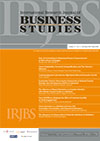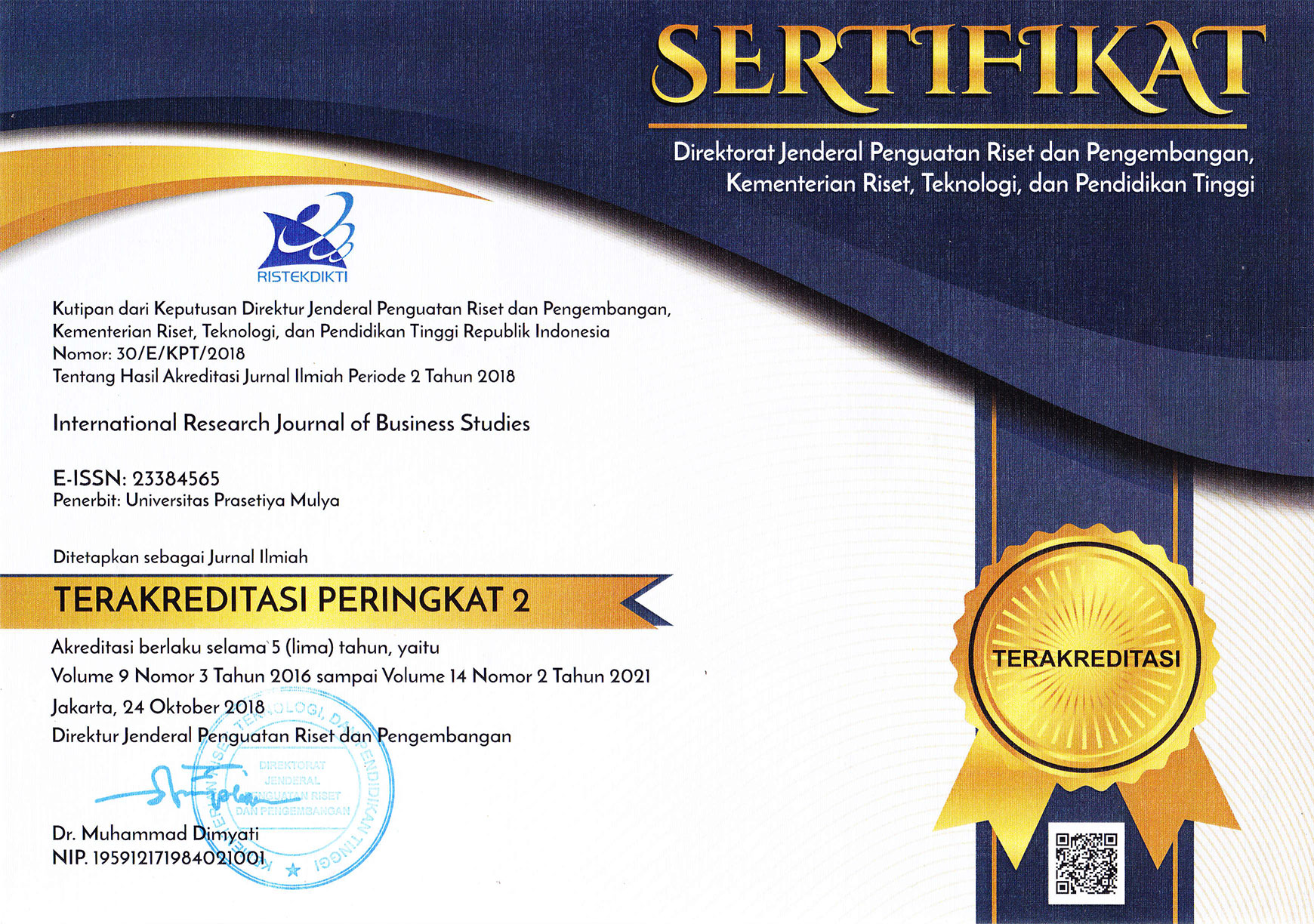Career Adaptability, Perceived Overqualification, and The Turnover Dilemma
DOI:
https://doi.org/10.21632/irjbs.17.3.225-238Keywords:
career adaptability, perceived overqualification, turnover intention, human resource developmentAbstract
This study examines the role of perceived overqualification as a mediator in the relationship between career adaptability and turnover intention among employees of PT. Kimia Farma Diagnostika. Involving 80 respondents, this study uses a quantitative approach and SEM-PLS analysis. The results show that career adaptability has a positive effect on turnover intention, where perceived overqualification functions as a mediator. Employees who feel they have higher abilities than needed tend to seek opportunities that are more in line with their potential, which increases the intention to leave the organization. These findings provide important insights for management in designing more effective employee retention strategies, as well as enrich the literature by combining these concepts. By understanding the factors that influence employees' decisions to stay or move, management can develop policies that increase job satisfaction and reduce turnover rates. This study also identifies limitations, such as the limited number of respondents, and suggests further research.
References
Bao, Y., & Zhong, W. (2023). Public service motivation helps: Understanding the influence of public employees’ perceived overqualification on turnover intentions. Australian Journal of Public Administration.
Biaobin, Y., Lin, Q., Yi, L., Qian, L., Dan, H., & Yiwei, C. (2021). The Effect of Overqualification on Employees' Turnover Intention: The Role of Organization Identity and Goal Orientation. Journal of Advanced Management Science Vol, 9(1).
Brynin, M. (2002). Overqualification in employment. Work, employment and society, 16(4), 637-654.
Bothma, C. F., & Roodt, G. (2013). The validation of the turnover intention scale. SA journal of human resource management, 11(1), 1-12.
Chan, S. H. J., & Mai, X. (2015). The relation of career adaptability to satisfaction and turnover intentions. Journal of Vocational Behavior, 89, 130-139.
Chan, S. H., Mai, X., Kuok, O. M., & Kong, S. H. (2016). The influence of satisfaction and promotability on the relation between career adaptability and turnover intentions. Journal of Vocational Behavior, 92, 167-175.
Cho, T. S. (2006). The effects of executive turnover on top management team's environmental scanning behavior after an environmental change. Journal of Business Research, 59(10-11), 1142-1150.
de Guzman, A. B., & Choi, K. O. (2013). The relations of employability skills to career adaptability among technical school students. Journal of Vocational Behavior, 82(3), 199-207.
Demerouti, E., Peeters, M. C., & van der Heijden, B. I. (2012). Work–family interface from a life and career stage perspective: The role of demands and resources. International Journal of Psychology, 47(4), 241-258.
Deng, H., Wu, W., Zhang, Y., Zhang, X., & Ni, J. (2022). The paradoxical effects of COVID-19 event strength on employee turnover intention. International Journal of Environmental Research and Public Health, 19(14), 8434.
Dong, B., Zheng, B., & Wang, Z. (2020). Career adaptability and turnover intention: A dual‐mediation model. The Career Development Quarterly, 68(2), 145-157.
Dwivedi, S. (2015). Turnover intentions: Scale construction & validation. The Indian Journal of Industrial Relations, 452-468.
Erdogan, B., & Bauer, T. N. (2009). Perceived overqualification and its outcomes: The moderating role of empowerment. Journal of applied psychology, 94(2), 557.
Fine, S., & Nevo, B. (2008). Too smart for their own good? A study of perceived cognitive overqualification in the workforce. The International Journal of Human Resource Management, 19(2), 346-355.
Greguras, G. J., & Diefendorff, J. M. (2009). Different fits satisfy different needs: linking person-environment fit to employee commitment and performance using self-determination theory. Journal of applied psychology, 94(2), 465.
Griffin, M. L., Hogan, N. L., & Lambert, E. G. (2014). Career stage theory and turnover intent among correctional officers. Criminal Justice and Behavior, 41(1), 4-19.
Guan, Y., Deng, H., Sun, J., Wang, Y., Cai, Z., Ye, L., ... & Li, Y. (2013). Career adaptability, job search self-efficacy and outcomes: A three-wave investigation among Chinese university graduates. Journal of Vocational Behavior, 83(3), 561-570.
Guan, Y., Zhou, W., Ye, L., Jiang, P., & Zhou, Y. (2015). Perceived organizational career management and career adaptability as predictors of success and turnover intention among Chinese employees. Journal of Vocational Behavior, 88, 230-237.
Ghozali, I. 2015.Aplikasi Analisis Multivariate dengan ProgramSPSS.Semarang: Badan Penerbit Universitas Diponegoro.
Hadi,S. 2015. Metodologi Riset. Yogyakarta. Pustaka Pelajar
Hartung, P. J., Porfeli, E. J., & Vondracek, F. W. (2008). Career adaptability in childhood. The career development quarterly, 57(1), 63-74.
Hayes, A. F. (2018). Partial, conditional, and moderated moderated mediation: Quantification, inference, and interpretation. Communication monographs, 85(1), 4-40.
Khan, J., Saeed, I., Zada, M., Nisar, H. G., Ali, A., & Zada, S. (2023). The positive side of overqualification: examining perceived overqualification linkage with knowledge sharing and career planning. Journal of knowledge management, 27(4), 993-1015.
Klehe, U. C., Zikic, J., Van Vianen, A. E., & De Pater, I. E. (2011). Career adaptability, turnover and loyalty during organizational downsizing. Journal of Vocational Behavior, 79(1), 217-229.
Jansen, K. J., & Kristof-Brown, A. (2006). Toward a multidimensional theory of person-environment fit. Journal of Managerial issues, 193-212.
Johnson, G. J., & Johnson, W. R. (2000). Perceived overqualification and dimensions of job satisfaction: A longitudinal analysis. The Journal of psychology, 134(5), 537-555.
Kaymakcı, R., Görener, A., & Toker, K. (2022). The perceived overqualification's effect on innovative work behaviour: Do transformational leadership and turnover intention matter?. Current Research in Behavioral Sciences, 3, 100068.
Khakwani, M. F. (2016). Impact of over qualification on turnover intention. Pollster Journal of Research, 3(1), 19-31.
Lee, H. M., Chou, M. J., & Wu, H. T. (2016). The measurement of perceived overqualification and the relationships among perceived overqualification, psychological empowerment, job satisfaction of private kindergarten teachers. European Journal of Research in Social Sciences, 4(8).
Maynard, D. C., Joseph, T. A., & Maynard, A. M. (2006). Underemploy- ment, job attitudes, and turnover intentions. Journal of Organizational Behavior, 27, 509–536.
Maynard, D. C., and Parfyonova, N. M. (2013). Perceived overqualification and withdrawal behaviours: examining the roles of job attitudes and work values. J. Occup. Organ. Psychol. 86, 435–455.
McKee-Ryan, F. M., & Harvey, J. (2011). “I have a job, but...”: A review of underemployment. Journal of Management, 37(4), 962-996.
Ng, T. H., & Feldman, D. C. (2010). The relationships of age with job attitudes: A meta-analysis. Personnel Psychology, 63, 677–718.
Podsakoff, P. M., MacKenzie, S. B., Lee, J. Y., & Podsakoff, N. P. (2003). Common method biases in behavioral research: a critical review of the literature and recommended remedies. Journal of applied psychology, 88(5), 879.
Qiu, H., Ye, B. H., Hung, K., & York, Q. Y. (2015). Exploring antecedents of employee turnoverintentions - Evidence of China’s hotel industry. Journal of China Tourism Research, 11(1), 53–66
Savickas, M. L. (1997). Career adaptability: An integrative construct for life‐span, life‐space theory. The career development quarterly, 45(3), 247-259.
Savickas, M. L., & Porfeli, E. J. (2012). Career Adapt-Abilities Scale: Construction, reliability, and measurement equivalence across 13 countries. Journal of vocational behavior, 80(3), 661-673.
Seifert, T. A., & Umbach, P. D. (2008). The effects of faculty demographic characteristics and disciplinary context on dimensions of job satisfaction. Research in Higher education, 49, 357-381.
Suyasa, P. T. Y. S., & Parman, J. L. S. (2007, August). Job satisfaction measurement: The alternative method. In Paper presented on International Conference of Industrial and Organizational (ICIOP), Yogyakarta.
Özpehlivan, M., & Acar, A. Z. (2016). Development and validation of a multidimensional job satisfaction scale in different cultures. Cogent Social Sciences, 2(1), 1237003.
Vinayak, R., Bhatnagar, J., & Agarwal, M. N. (2021, October). When and how does perceived overqualification lead to turnover intention? A moderated mediation model. In Evidence-based HRM: a Global Forum for Empirical Scholarship (Vol. 9, No. 4, pp. 374-390). Emerald Publishing Limited.
Wald, S. (2005). The impact of overqualification on job search. International Journal of Manpower, 26(2), 140-156.
Wang, Q., Gan, K. P., Wei, H. Y., Sun, A. Q., Wang, Y. C., & Zhou, X. M. (2024). Public service motivation and public employees' turnover intention: the role of job satisfaction and career growth opportunity. Personnel Review, 53(1), 99-118.
Wassermann, M., Fujishiro, K., & Hoppe, A. (2017). The effect of perceived overqualification on job satisfaction and career satisfaction among immigrants: Does host national identity matter?. International Journal of Intercultural Relations, 61, 77-87.
Yang, W., Guan, Y., Lai, X., She, Z., & Lockwood, A. J. (2015). Career adaptability and perceived overqualification: Testing a dual-path model among Chinese human resource management professionals. Journal of Vocational Behavior, 90, 154-162.
Ye, X., Li, L., & Tan, X. (2017). Organizational support: Mechanisms to affect perceived overqualification on turnover intentions: a study of Chinese repatriates in multinational enterprises. Employee Relations, 39(7), 918-934.
Zheng, B., & Wang, Z. (2017). Perceived overqualification and its outcomes: The moderating role of organizational learning. Social Behavior and Personality: an international journal, 45(10), 1675-1690.
Downloads
Submitted
Accepted
Published
How to Cite
Issue
Section
License
Copyright (c) 2024 Winastanto Wibowo, Fendy Suhariadi, Fiona Niska Dinda Nadia (Author)

This work is licensed under a Creative Commons Attribution-ShareAlike 4.0 International License.
Journal Author(s) Rights
For IRJBS to publish and disseminate research articles, we need publishing rights (transferred from the author(s) to the publisher). This is determined by a publishing agreement between the Author(s) and IRJBS. This agreement deals with the transfer or license of the copyright of publishing to IRJBS, while Authors still retain significant rights to use and share their own published articles. IRJBS supports the need for authors to share, disseminate and maximize the impact of their research and these rights, in any databases.
As a journal Author, you have rights to many uses of your article, including use by your employing institute or company. These Author rights can be exercised without the need to obtain specific permission. Authors publishing in IRJBS journals have comprehensive rights to use their works for teaching and scholarly purposes without needing to seek permission, including:
- use for classroom teaching by Author or Author's institution and presentation at a meeting or conference and distributing copies to attendees;
- use for internal training by the author's company;
- distribution to colleagues for their research use;
- use in a subsequent compilation of the author's works;
- inclusion in a thesis or dissertation;
- reuse of portions or extracts from the article in other works (with full acknowledgment of the final article);
- preparation of derivative works (other than commercial purposes) (with full acknowledgment of the final article);
- voluntary posting on open websites operated by the author or the author’s institution for scholarly purposes,
(But it should follow the open access license of Creative Common CC-by-SA License).
Authors/Readers/Third Parties can copy and redistribute the material in any medium or format, as well as remix, transform, and build upon the material for any purpose, even commercially. Still, they must give appropriate credit (the name of the creator and attribution parties (authors' detail information), a copyright notice, an open access license notice, a disclaimer notice, and a link to the material), provide a link to the license, and indicate if changes were made (Publisher indicates the modification of the material (if any) and retain an indication of previous modifications.
Authors/Readers/Third Parties can read, print and download, redistribute or republish the article (e.g. display in a repository), translate the article, download for text and data mining purposes, reuse portions or extracts from the article in other works, sell or re-use for commercial purposes, remix, transform, or build upon the material, they must distribute their contributions under the same license as the original Creative Commons Attribution-ShareAlike (CC BY-SA).
This work is licensed under a Creative Commons Attribution-ShareAlike 4.0 International License.








